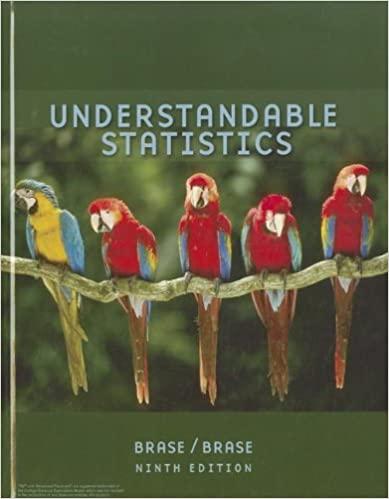Discuss each of the following topics in class or review the topics on your own. Then write
Question:
Discuss each of the following topics in class or review the topics on your own. Then write a brief but complete essay in which you summarize the main points. Please include formulas and graphs as appropriate.
1. Discuss what we mean by a binomial experiment. As you can see, a binomial process or binomial experiment involves a lot of assumptions! For example, all the trials are supposed to be independent and repeated under identical conditions. Is this always true? Can we always be completely certain that the probability of success does not change from one trial to the next? In the real world, there is almost nothing we can be absolutely sure about, so the theoretical assumptions of the binomial probability distribution often will not be completely satisfied. Does that mean we cannot use the binomial distribution to solve practical problems? Looking at this chapter, the answer seems to be that we can indeed use the binomial distribution even if not all the assumptions are exactly met. We find in practice that the conclusions are sufficiently accurate for our intended application. List three applications of the binomial distribution for which you think, although some of the assumptions are not exactly met, there is adequate reason to apply the binomial distribution anyhow.
2. Why do we need to learn the formula for the binomial probability distribution? Using the formula repeatedly can be very tedious. To cut down on tedious calculations, most people will use a binomial table such as the one found in Appendix II of this book.
(a) However, there are many applications for which a table in the back of any book is not adequate. For instance, compute
P(r = 3) where n = 5 and p = 0.735
Can you find the result in the table? Do the calculation by using the formula. List some other situations in which a table might not be adequate to solve a particular binomial distribution problem.
(b) The formula itself also has limitations. For instance, consider the difficulty of computing
P(r ≥ 285) where n = 500 and p = 0.6
What are some of the difficulties you run into? Consider the calculation of P(r = 285). You will be raising 0.6 and 0.4 to very high powers; this will give you very, very small numbers. Then you need to compute C500,285, which is a very, very large number. When combining extremely large and extremely small numbers in the same calculation, most accuracy is lost unless you carry a huge number of significant digits. If this isn’t tedious enough, consider the steps you need to compute
P(r ≥ 285) = P(r = 285) + P(r = 286) + ···· + P(r = 500)
Does it seem clear that we need a better way to estimate P(r ≥ 285)? In Chapter 6, you will learn a much better way to estimate binomial probabilities when the number of trials is large.
3. In Chapter 3, we learned about means and standard deviations. In Section 5.1, we learned that probability distributions also can have a mean and standard deviation. Discuss what is meant by the expected value and standard deviation of a binomial distribution. How does this relate back to the material we learned in Chapter 3 and Section 5.1?
4. In Chapter 2, we looked at the shapes of distributions. Review the concepts of skewness and symmetry; then categorize the following distributions as to skewness or symmetry:
(a) A binomial distribution with n = 11 trials and p = 0.50
(b) A binomial distribution with n = 11 trials and p = 0.10
(c) A binomial distribution with n = 11 trials and p = 0.90
In general, does it seem true that binomial probability distributions in which the probability of success is close to 0 are skewed right, whereas those with probability of success close to 1 are skewed left?
Step by Step Answer:

Understandable Statistics Concepts And Methods
ISBN: 9780618986927
9th Edition
Authors: Charles Henry Brase, Corrinne Pellillo Brase





